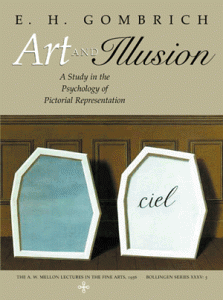E.H. Gombrich analyzes art history and aesthetic vision in light of present-day notions of visual perception and psychology.

We do not have to turn to art to show that this view is erroneous. Any psychology textbook will provide us with baffling examples that show the complexity of the issues involved. … Illusion, we will find, is hard to describe or analyze, for though we may be intellectually aware of the fact that any given experience must be an illusion, we cannot, strictly speaking, watch ourselves having an illusion. …
I believe it is only by considering these psychological aspects of image making and image reading that we may come closer to an understanding of the central problem of the history of art that I set out in the Introduction-the problem, that is, why representation should have a history; why it should have taken mankind so long to arrive at a plausible rendering of visual effects that create the illusion of life-likeness … It is these conventions, we remember, which enable the art historian to date a work such as Constable’s Wivenhoe Park despite its apparent truthfulness; it is their totality which makes up what we call “style” in painting. …
The equation of the way things are represented with the way things are “seen” is surely misleading. No child sees its mother in terms of those crude schemata it draws. But there are other flaws in this tidy story. The one most frequently discussed is the awkward fact that prehistoric artists knew how to render animals very convincingly—at least to us who are rarely well acquainted with bison. But we have seen that in all styles the artist has to rely on a vocabulary of forms and that it is the knowledge of this vocabulary rather than a knowledge of things that distinguishes the skilled from the unskilled artist. This need for such schemata was demonstrated in the “pathology of portrayal” in our Chapter II. What accounts for the ease or difficulty in rendering a given building or landscape is not so much the intrusion of knowledge as the lack of schemata.
But this criticism should not obscure the value of the traditional distinction for however we interpret the facts, it remains true that all representations can be somehow arranged along a scale which extends from the schematic to the impressionist. What is more, it remains important that there exists a natural pull toward the schematic which artists such as Giotto or Constable succeeded in overcoming. Because of this gravitation toward the schematic or “conceptual,” we have a right to speak of “primitive” modes of representation, modes, that is, which assert themselves unless they are deliberately counteracted.
Gombrich, E.H. 2000. Art and Illusion: A Study in the Psychology of Pictorial Representation. Princeton, NJ: Princeton University Press. pp. 3-7, 291-294. || Amazon || WorldCat
